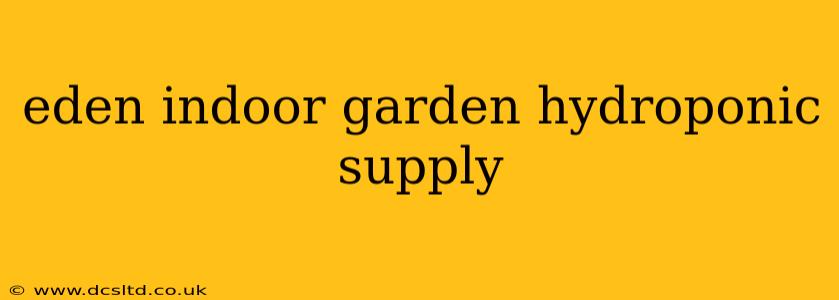Creating a thriving indoor garden using hydroponics can be incredibly rewarding, offering fresh produce year-round regardless of climate or space constraints. But navigating the world of hydroponic supplies can feel overwhelming. This guide will walk you through the essential equipment and considerations for setting up your own Eden-like indoor garden, focusing on quality and efficiency. We'll explore everything from choosing the right system to maintaining optimal growing conditions.
What is Hydroponics and Why Choose It for an Indoor Garden?
Hydroponics is a method of growing plants without soil, using mineral nutrient solutions in a water solvent. This technique offers several advantages for indoor gardening, including:
- Faster Growth: Plants absorb nutrients directly, leading to faster growth cycles compared to soil-based gardening.
- Higher Yields: Optimized nutrient delivery results in increased yields in smaller spaces.
- Water Conservation: Hydroponics uses significantly less water than traditional gardening.
- Pest and Disease Control: The controlled environment minimizes pest and disease problems.
- Year-Round Growing: Independent of outdoor weather conditions, you can grow plants year-round.
Essential Hydroponic Supplies for Your Indoor Eden
Setting up your hydroponic system requires careful selection of key components. Here's a breakdown of the essentials:
1. Hydroponic System: Choosing the Right One
Several hydroponic systems cater to different needs and experience levels. Popular choices include:
- Deep Water Culture (DWC): Simple and cost-effective, ideal for beginners. Plants are suspended with their roots submerged in a nutrient solution.
- Nutrient Film Technique (NFT): A more advanced system where a thin film of nutrient solution flows continuously over the plant roots. Excellent for faster growth and higher yields.
- Drip System: Nutrients are delivered directly to the base of each plant, offering precise control over watering and fertilization.
- Ebb and Flow (Flood and Drain): The growing medium is periodically flooded with nutrient solution, then drained, ensuring consistent moisture.
2. Growing Medium (if applicable):
Some hydroponic systems require a growing medium to support the plants, such as:
- Rockwool: A sterile, inert medium that holds moisture and nutrients effectively.
- Coco Coir: A sustainable and environmentally friendly option derived from coconut husks.
- Clay Pebbles (Hydroton): Inert and porous, providing excellent aeration for roots.
3. Grow Lights: Illuminating Your Indoor Oasis
Adequate lighting is critical for healthy plant growth. Consider:
- LED Grow Lights: Energy-efficient and offer a full spectrum of light ideal for photosynthesis.
- High-Pressure Sodium (HPS) Lights: Powerful but less energy-efficient than LEDs.
4. Reservoir and Pump (for most systems):
The reservoir holds the nutrient solution, and a pump circulates it through the system. Choose a reservoir size appropriate for your system and plant count.
5. Air Pump and Air Stones (for DWC systems):
Essential for oxygenating the nutrient solution in DWC setups, preventing root rot.
6. Nutrient Solution: Feeding Your Plants
Selecting the right nutrient solution is crucial. Consider using a complete hydroponic nutrient formulated for your specific plants.
7. pH Meter and TDS Meter: Monitoring Your Environment
Regularly monitoring the pH and TDS (Total Dissolved Solids) levels of your nutrient solution is vital for optimal plant health.
H2: What are the different types of hydroponic systems?
As mentioned above, several hydroponic systems exist, each with its advantages and disadvantages. Deep Water Culture (DWC), Nutrient Film Technique (NFT), Drip systems, and Ebb and Flow systems are all popular choices, each best suited for different plants and experience levels. Researching each type thoroughly will help you choose the best system for your needs and space constraints.
H2: How much does a hydroponic system cost?
The cost of a hydroponic system varies widely depending on the size, complexity, and components you choose. A basic DIY setup can be relatively inexpensive, while larger, more sophisticated systems can cost significantly more. Consider your budget and desired scale when planning your setup.
H2: What are the benefits of using a hydroponic system?
Hydroponic systems offer many benefits over traditional soil-based gardening, including faster growth, higher yields, water conservation, reduced pest and disease problems, and the ability to grow plants year-round regardless of climate. These advantages make hydroponics a highly efficient and productive gardening method, especially for indoor environments.
H2: Is hydroponics difficult to learn?
The difficulty of hydroponics depends on the chosen system and your experience level. Simple systems like DWC are relatively easy to learn, while more complex systems may require more knowledge and attention. Plenty of resources, including online tutorials and communities, can help you learn the necessary skills and troubleshoot problems. Start with a smaller, simpler system to gain experience before progressing to more advanced setups.
Conclusion: Cultivate Your Indoor Eden
Building your own hydroponic garden is a rewarding journey. By carefully selecting the right equipment, understanding the principles of hydroponics, and maintaining a diligent approach, you can create a thriving indoor ecosystem producing fresh, healthy produce all year round. Remember to start small, learn as you go, and enjoy the process of cultivating your own personal Eden.
